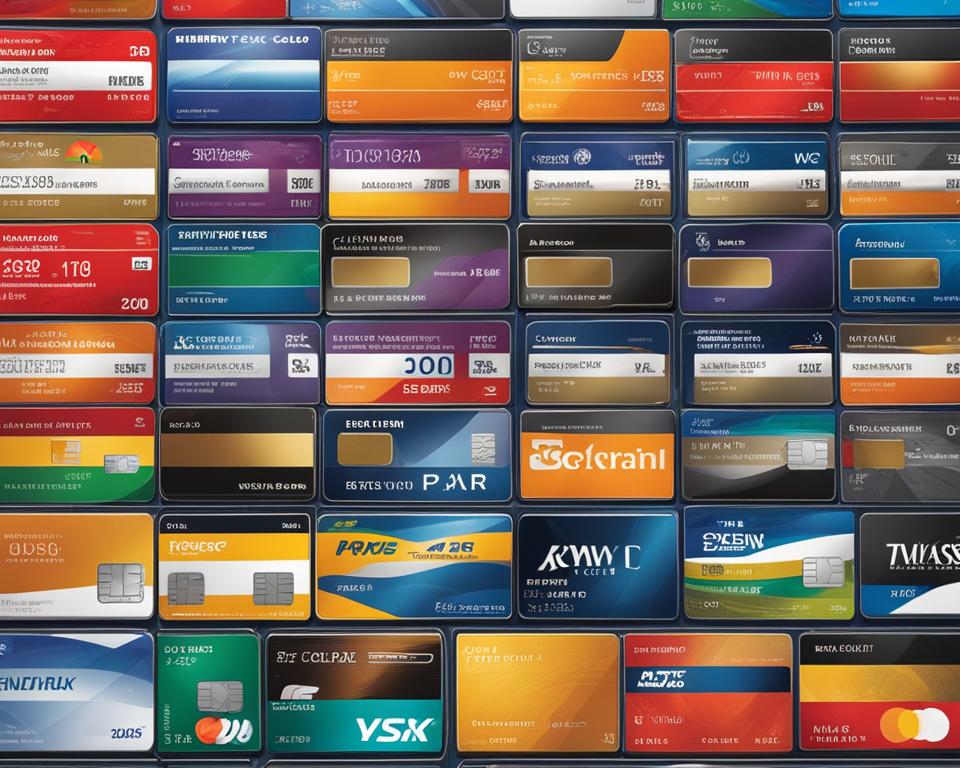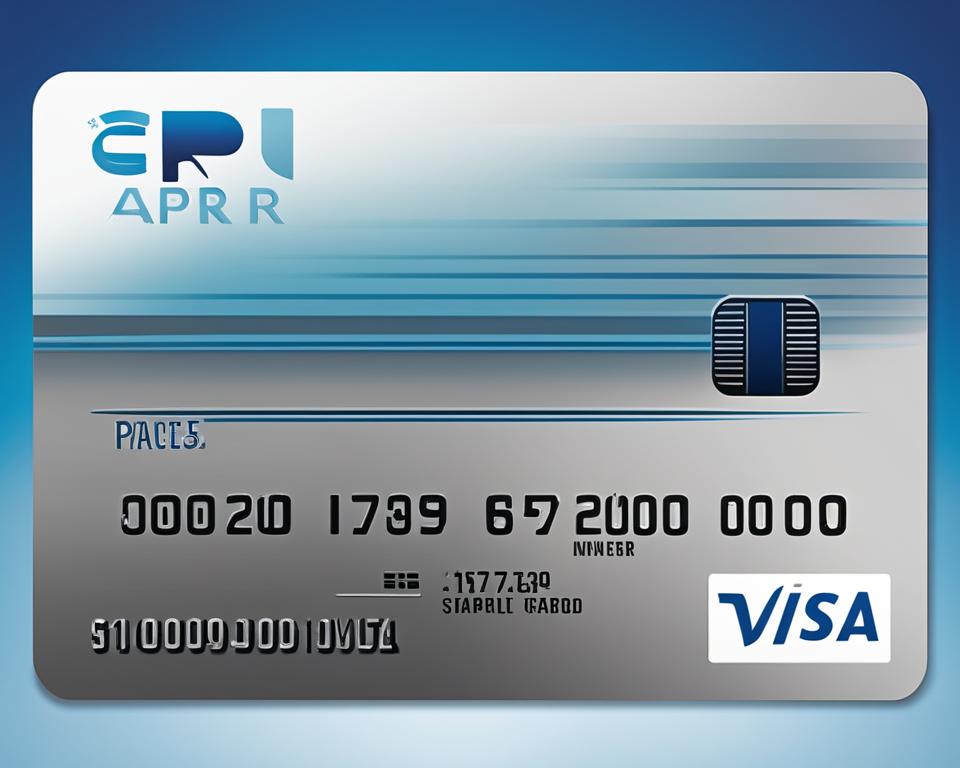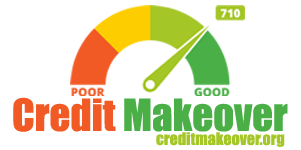Are you wondering, “What credit card should I get?” Look no further! In this comprehensive guide, we’ll walk you through the process of choosing the best credit card for your needs and preferences. Whether you’re a beginner or someone looking to maximize your rewards, we’ve got you covered.
With so many credit card options available, finding the right one can seem overwhelming. But fear not! By following a few simple steps and considering key factors, you’ll be on your way to selecting the perfect credit card in no time.
Key Takeaways:
- Determine your credit score before applying for a credit card.
- Identify the type of credit card that aligns with your financial goals and needs.
- Consider factors such as annual fees, APR, and rewards programs.
- Narrow down your choices by asking the right questions.
- Apply for the card that offers you the highest overall value.
Check Your Credit Score
Before choosing a credit card, it’s important to check your credit score. Your credit score is a numerical representation of your creditworthiness and plays a crucial role in determining your eligibility for different cards and interest rates. By understanding your credit score, you can make informed decisions about which credit cards are best suited to your financial situation.
Why Your Credit Score Matters
Your credit score is based on information from your credit reports, which are compiled by credit bureaus. These reports contain details about your borrowing history, including payment history, outstanding debt, and credit utilization. Lenders use this information to assess your risk as a borrower and make lending decisions.
By checking your credit score, you can identify any negative factors that may be impacting your score and take steps to improve it. A higher credit score can open doors to better credit card offers, lower interest rates, and favorable terms.
How to Check Your Credit Score
To check your credit score, you can obtain a copy of your credit report from the three major credit bureaus: Experian, Equifax, and TransUnion. The Fair Credit Reporting Act (FCRA) entitles you to one free copy of your credit report from each bureau every 12 months. You can request your credit reports online, by mail, or by phone.
Tip: To save time, you can use websites like AnnualCreditReport.com, which provide convenient access to all three credit reports in one place.
Once you have your credit reports, review them carefully for accuracy. Look for any errors, such as incorrect personal information, accounts that don’t belong to you, or late payments that were reported incorrectly. Dispute any mistakes you find with the credit bureaus to have them corrected. Correcting errors can help improve your credit score and increase your chances of qualifying for better credit card offers.
Track Your Credit Score over Time
Checking your credit score regularly is essential for monitoring your credit health and identifying any changes or potential issues. Some credit card issuers and financial tools even provide free credit score monitoring services that allow you to track your score over time.
Monitoring your credit score gives you a better understanding of how your financial actions impact your creditworthiness. It also helps you detect fraudulent activity and identity theft, as any unauthorized accounts or inquiries will likely be reflected in your credit report.
Remember, maintaining a good credit score is an ongoing process. By regularly reviewing and improving your credit score, you can position yourself for better credit card options and financial opportunities.
| Credit Bureau | Website |
|---|---|
| Experian | experian.com |
| Equifax | equifax.com |
| TransUnion | transunion.com |
Identify the Type of Credit Card You Need
When it comes to choosing a credit card, it’s essential to understand the different types available and determine which one suits your needs best. There are three main types of credit cards to consider: credit-building cards, low-interest cards, and rewards cards.
Credit-Building Cards
If you’re looking to establish or rebuild your credit, credit-building cards are an excellent option. These cards are designed to help individuals with limited or poor credit histories improve their creditworthiness. Two common types of credit-building cards are student cards and secured cards.
Student cards are specially tailored to meet the needs of students who are new to credit. These cards often come with lower credit limits and may offer unique benefits such as cash back on purchases relevant to student life, like textbooks or school supplies.
Secured cards require a security deposit, which acts as collateral for the credit limit. By responsibly using a secured card, you can demonstrate your ability to manage credit and build a positive credit history over time.
Low-Interest Cards
For individuals looking to save on interest charges, low-interest cards are a great choice. These cards offer a lower Annual Percentage Rate (APR) compared to standard credit cards. With a low-interest card, you can minimize the amount of interest you’ll need to pay if you carry a balance from month to month. Some low-interest cards also offer attractive balance transfer options, allowing you to consolidate high-interest debt onto one card with a lower interest rate.
Rewards Cards
If you pay off your credit card balance in full each month and want to earn rewards for your spending, rewards cards are the way to go. These cards offer various incentives such as points, miles, or cash back for every dollar you spend. Rewards programs vary, so it’s essential to compare the different options available to find one that aligns with your spending habits and offers desirable rewards.
Here’s a summary of the different types of credit cards:
| Type of Credit Card | Description |
|---|---|
| Credit-Building Cards | Designed for individuals looking to establish or improve their credit history |
| Low-Interest Cards | Offer a lower Annual Percentage Rate (APR) and can help you save on interest charges |
| Rewards Cards | Earn points, miles, or cash back for every dollar spent, ideal for those who pay off their balance in full |

Understanding the type of credit card you need will help you narrow down your options and choose the card that aligns with your financial goals and preferences.
Narrow Your Choices with the Right Questions
When comparing credit cards, ask yourself specific questions to narrow down your choices. Consider whether the card will help you build credit, the cost to open an account, the possibility of upgrading to a better card, and any potential rewards or benefits.
Will the card help you build credit?
If one of your goals is to build or improve your credit score, look for cards that offer credit-building features. These cards may be designed for individuals with limited or poor credit history and may have lower credit limits or require a security deposit. Choosing a card that reports your activity to the major credit bureaus can help you establish a positive credit history.
What is the cost to open an account?
Take into consideration any fees associated with opening a credit card account. Some cards have an annual fee that you’ll need to pay each year, while others have no annual fee. Additionally, some cards may require an initial security deposit, especially if you’re applying for a secured credit card.
Is it possible to upgrade to a better card?
Consider whether the card you’re considering allows for upgrades to better cards in the future. This option can be beneficial if you’re starting with a basic or limited credit card and want the opportunity to earn more rewards or enjoy additional benefits down the line. Upgrading instead of applying for a brand new card can save you time and effort.
What potential rewards or benefits are offered?
Think about what type of rewards or benefits you’re interested in. Some cards offer cash back or statement credits, while others provide travel rewards or discounts on specific purchases. Consider your spending habits and priorities to determine which type of rewards or benefits would be most valuable to you.
Note: NerdWallet’s credit card comparison tool is a helpful resource that can further assist you in comparing various credit card options. It allows you to filter results based on your credit score and monthly spending, making it easier to find the right card for your needs.
| Credit Card Features | Credit Limit | Annual Fee | Rewards |
|---|---|---|---|
| Card A | $2,000 | $0 | 1.5% cash back on all purchases |
| Card B | $5,000 | $95 | 2% cash back on groceries and gas |
| Card C | $10,000 | $150 | 3x points on travel and dining |
| Card D | $3,000 | $0 | 5% cash back rotating categories |
Apply for the Card with the Highest Value
Once you’ve narrowed down your choices, it’s time to apply for the credit card that offers you the highest overall value. Take the time to review the details of each card and consider additional features that set them apart. Look for benefits such as credit limit increases, interest earned on deposits, or special perks like priority boarding or free checked bags.

When you’re ready to apply, make sure you include all income sources you have access to, not just personal income. This can improve your chances of approval and potentially lead to a higher credit limit. Be prepared to provide accurate information about your employment, income, and other financial details as part of the application process.
“Applying for a credit card that aligns with your financial goals allows you to maximize the benefits and rewards.”
Remember, choosing a credit card is about finding the right fit for your needs and financial situation. By applying for the card with the highest overall value, you’re setting yourself up for a rewarding credit card experience.
| Credit Card | Annual Fee | Rewards Program | Additional Benefits |
|---|---|---|---|
| Card A | $0 | 1% cash back on all purchases | Introductory 0% APR for first 12 months |
| Card B | $95 | 2% cash back on dining and travel | Airport lounge access |
| Card C | $0 | 5% cash back on rotating categories | Free checked bags on eligible flights |
Consider Cash Back or Statement Credit
When choosing a rewards card, it’s essential to consider whether you prefer cash back or statement credit as your reward option. Both options have their advantages, and your preference will depend on your spending habits and financial goals.
Cash back:
If you opt for cash back, you’ll receive a percentage of your spending back in cash. This can be a great option if you prefer immediate savings or if you want the flexibility to use the cash as you see fit. Whether you use it to pay off your credit card bill or treat yourself to something special, cash back rewards put money back in your pocket.
Statement credit:
On the other hand, statement credit applies your earned rewards points towards reducing the amount you owe on your credit card bill. This can be an effective way to lower your overall credit utilization and decrease your outstanding balance. Statement credit rewards provide financial relief and help you manage your credit card debt more efficiently.
Rewards points:
Some credit cards offer rewards points as a form of incentive. These points can typically be redeemed for various rewards, including travel benefits, merchandise, or gift cards. Rewards points can be an excellent choice if you enjoy the flexibility of choosing your preferred rewards and if you have specific redemption goals in mind.
When deciding between cash back, statement credit, or rewards points, consider factors such as your spending habits, financial objectives, and how you plan to utilize your rewards. It’s also worth reviewing the terms and conditions of the credit card’s rewards program to ensure that it aligns with your preferences.
By understanding the different reward options available, you can make an informed decision and select the rewards card that best suits your needs.
Determine Your Spending Habits
To maximize the benefits of a rewards card, it’s essential to evaluate your spending habits in several categories. By assessing your average monthly expenditures, you can choose a card that offers higher rewards rates on the categories you spend the most on.
Consider the following spending habits:
- Grocery spending
- Purchases at big box stores
- Gas expenses
- Public transportation
- Restaurant spending
- Online shopping
Knowing these details will help you make an informed decision while selecting a rewards card that aligns with your spending patterns and maximizes your potential rewards.

Review Your Travel Habits
If you frequently travel, especially by plane, it’s worth considering a credit card that offers travel rewards. These rewards can help you save money on flights, hotels, and other travel expenses. But before selecting a travel rewards card, it’s important to review your travel habits and preferences to find the best fit for you.
If your travel is mostly domestic, a card that offers rewards and benefits specific to domestic travel may be ideal. On the other hand, if you frequently travel internationally, you’ll want to look for a card that provides perks such as waived foreign transaction fees and travel insurance.
Additionally, consider whether you prefer to travel alone or with a companion or family members. Some credit cards offer benefits like companion travel tickets or discounted rates for family members, making them a great choice for those who frequently travel with others.
Here are some key factors to consider when reviewing your travel habits:
- Frequency of travel
- Preferred travel destinations (domestic or international)
- Travel companions (solo, companion, or family)
Once you have a clear understanding of your travel habits, you can choose a credit card that aligns with your needs and maximizes your travel rewards.
| Credit Card | Travel Rewards | Annual Fee | Other Benefits |
|---|---|---|---|
| Airline Rewards Card | Earn miles for flights and other travel expenses | $95 | Priority boarding, free checked bags |
| Hotel Rewards Card | Earn points for hotel stays and upgrades | $0 | Complimentary breakfast, room upgrades |
| General Travel Rewards Card | Earn points or miles for all travel-related expenses | $150 | Airport lounge access, travel insurance |
Remember, travel rewards cards often come with annual fees, so it’s important to assess the value of the rewards and benefits against the cost of the card. If you travel frequently and can take advantage of the perks offered, the annual fee may be well worth it.
Note: The table above provides an example of different travel rewards cards and their features. The actual benefits, fees, and rewards may vary depending on the specific credit card issuer.
By taking the time to review your travel habits and choosing the right travel rewards card, you can enhance your travel experience while earning valuable rewards.
Tailor the Card to Your Business or Student Needs
If you have a small business, consider applying for a small business credit card that offers features tailored to business owners. These cards often come with perks such as higher credit limits, expense tracking tools, and rewards for business expenses. By using a small business credit card, you can separate your personal and business expenses, making it easier to manage your finances and track your business-related spending.
For students, student credit cards are designed to help establish credit and earn rewards tailored to student spending. These cards typically have lower credit limits and may come with additional benefits like cashback rewards on everyday student expenses such as textbooks, groceries, and dining. This can help students build their credit history while maximizing their purchasing power.
“Small business credit cards provide a range of features and benefits to help business owners manage their finances and streamline their operations. Student credit cards, on the other hand, offer students a convenient and responsible way to build credit while enjoying rewards and perks tailored to their needs.”
Before applying for either type of card, be sure to review the eligibility requirements and consider if you meet the necessary criteria. Small business credit cards usually require an established business with a certain revenue threshold, while student credit cards may require proof of enrollment at a recognized educational institution.
Benefits of Small Business Credit Cards
Here are some key benefits of using a small business credit card:
- Higher credit limits: Small business credit cards often come with higher credit limits compared to personal credit cards, providing your business with greater purchasing power.
- Expense tracking tools: Many small business credit cards offer expense tracking features to help you monitor and categorize your business expenses, making it easier for tax preparation and budgeting.
- Rewards for business expenses: Some small business credit cards offer bonus rewards or cashback on business-related spending categories such as office supplies, advertising, or travel expenses.
- Employee cards: You can issue employee cards with individual spending limits, allowing you to easily track and manage your employees’ business spending while earning rewards.
Benefits of Student Credit Cards
Here are some key benefits of using a student credit card:
- Building credit history: Student credit cards provide an opportunity for students to start building their credit history by using credit responsibly and making timely payments.
- Cashback rewards: Many student credit cards offer cashback rewards on everyday student expenses such as textbooks, groceries, and dining, helping students save money on their purchases.
- Financial literacy resources: Some student credit cards provide educational resources and tools to help students learn about personal finance and develop responsible money management habits.
- Purchase protection: Student credit cards often come with purchase protection benefits such as extended warranties or fraud protection to safeguard against unauthorized transactions.
Determine which type of card aligns with your needs and circumstances. Whether you’re a small business owner or a student, there are credit cards available to help you manage your finances and earn rewards tailored to your specific requirements.
Understand Rewards Types
When it comes to choosing a rewards card, understanding the different types of rewards is essential. By considering your spending patterns and preferences, you can select a card that offers the most value for your needs. Here are some key factors to keep in mind:
Flat-Rate Rewards vs. Category-Specific Rewards
Some rewards cards offer flat-rate rewards on all purchases, meaning you earn a certain percentage back on every dollar you spend. This can be a great option if you want simplicity and consistency in your rewards.
On the other hand, there are cards that provide higher earnings in specific categories, such as groceries, dining, or online shopping. If you spend heavily in these categories, a card that offers elevated rewards in those areas can help you maximize your earnings.
“Choosing between flat-rate rewards and category-specific rewards ultimately depends on your spending habits and priorities. Consider where you spend the most and how important it is for you to earn more in those areas.”
Consider Rewards Value and Redemption Options
When evaluating rewards cards, it’s crucial to assess the value of the rewards and how quickly you can earn and redeem them. Some cards offer higher rewards value, allowing you to earn more for every dollar spent. Additionally, consider whether the rewards have an expiration date or if they can be accumulated over time.
Table: Rewards Card Comparison
| Card Name | Flat-Rate Rewards (%) | Category-Specific Rewards (%) | Rewards Value | Redemption Options |
|---|---|---|---|---|
| Card A | 1.5% | 2% on dining, 3% on travel |
High | Cash back, travel rewards |
| Card B | 2% | 1% on all purchases | Moderate | Cash back, statement credit |
| Card C | 1% | 4% on groceries | High | Gift cards, merchandise |
Redemption Options
Consider the redemption options available with each rewards card. Common redemption options include cash back, statement credit, travel rewards, gift cards, and merchandise. Choose a card that offers redemption options that align with your preferences and provide the most value.
By understanding the different types of rewards and evaluating their value, you can select the rewards card that best fits your spending habits and financial goals. Choose wisely to make the most of your credit card rewards and enjoy the benefits.
Consider the Annual Fee
When choosing a credit card, it’s important to take into account the annual fee. Many rewards cards charge an annual fee, but the rewards and benefits they offer can often outweigh the cost. If you’re someone who values earning significant rewards and maximizing your credit card benefits, opting for a card with an annual fee may be a smart choice.
However, if you prefer to avoid annual fees altogether, there are still excellent credit card options available. Some credit card issuers offer no-annual-fee versions of their rewards cards, allowing you to enjoy the perks without the additional cost. These no-annual-fee cards can be a great fit for individuals who want to keep their expenses low but still enjoy the benefits of a rewards program.
When deciding whether to choose a credit card with an annual fee or a no-annual-fee card, it’s essential to compare the rewards value against the annual fee. Consider the potential rewards you can earn, such as cash back, travel rewards, or statement credits. Calculate how much value those rewards would provide over the course of a year compared to the annual fee.
Comparison of Rewards Value and Annual Fee
| Credit Card | Annual Fee | Rewards | Estimated Annual Value |
|---|---|---|---|
| Credit Card A | $95 | 3% cash back on dining and travel 1% cash back on all other purchases |
$500 |
| Credit Card B | No annual fee | 2% cash back on all purchases | $400 |
| Credit Card C | $120 | 5% cash back on rotating categories 1% cash back on all other purchases |
$550 |
In this example, Credit Card A has a $95 annual fee but offers 3% cash back on dining and travel, providing an estimated annual value of $500. Credit Card B has no annual fee and offers 2% cash back on all purchases, providing an estimated annual value of $400. Credit Card C has a higher annual fee of $120 but offers 5% cash back on rotating categories, resulting in an estimated annual value of $550.
By comparing the estimated annual values against the annual fees, you can determine which card provides the greatest rewards greater than the cost. In this case, while Credit Card C has the highest annual fee, its estimated annual value exceeds the cost. However, it’s important to consider your personal spending habits and preferences when making a decision.
Remember, choosing a credit card with an annual fee is only worthwhile if the rewards and benefits you receive surpass the cost. Take the time to assess your spending patterns, evaluate reward redemption options, and determine which credit card offers the best overall value for your financial needs.
Focus on Ongoing APR and Interest Charges
When selecting a credit card, it’s crucial to focus on the ongoing APR (Annual Percentage Rate) to minimize interest charges. The ongoing APR represents the interest rate applied to any outstanding balance on the credit card. By choosing a credit card with a lower ongoing APR, you can save significantly on interest charges, especially if you plan to carry a balance.
One type of credit card that can help you reduce interest charges is a low-interest card. These cards offer interest rates that are lower than the average credit card APR. They are particularly beneficial for individuals who anticipate carrying a balance on their credit card, as the lower interest rates can result in substantial savings over time.
To provide even more flexibility in managing your finances, some credit cards offer a promotional 0 percent APR on new purchases for a specific period. This promotional APR can be valuable if you have a big-ticket item to finance or if you prefer to pay off your purchase over several months without incurring interest charges.
It’s important to consider your financial needs and goals when choosing a credit card. By focusing on the ongoing APR and interest charges, you can make a more informed decision and optimize your credit card usage to reduce expenses and save money.
| Credit Card Type | Ongoing APR |
|---|---|
| Low-Interest Card | 9.99% – 14.99% |
| Rewards Card | 15.99% – 24.99% |
| Balance Transfer Card | 0% – 5.99% |
Note: The ongoing APRs listed are for illustrative purposes only and may vary depending on the credit card issuer and individual creditworthiness.

Conclusion
Choosing the right credit card is a significant decision that requires careful consideration. By evaluating factors such as your credit score, desired card type, spending habits, and the value offered by different cards, you can make an informed choice. Consider the long-term benefits, including rewards programs and ongoing APR, to ensure that the card aligns with your financial goals.
When making your selection, opt for the card that offers the highest overall value for your specific needs. Remember to use your credit card responsibly, paying off your balance in full each month to maximize its benefits. By choosing wisely and using your credit card responsibly, you can achieve your financial objectives and make the most of your card’s features.
For credit card recommendations and guidance on finding the best credit card for your needs, consult reputable financial resources, and utilize comparison tools. Keep in mind that your unique circumstances and financial goals should ultimately guide your decision. Take the time to assess your options and select the credit card that will best support your financial journey.
FAQ
How do I check my credit score?
You can obtain your credit score from the three major credit bureaus: Experian, Equifax, and TransUnion. You can access one free copy of your credit report from each bureau every 12 months.
What are the different types of credit cards available?
There are three main types of credit cards: credit-building cards, low-interest cards, and rewards cards. Credit-building cards are suitable for establishing or rebuilding credit, low-interest cards are ideal for saving on interest charges, and rewards cards offer points, miles, or cash back for every dollar spent.
How can I narrow down my credit card choices?
Consider factors such as annual fees, APR, rewards programs, and potential benefits when comparing credit cards. Use NerdWallet’s credit card comparison tool to filter results based on your credit score and monthly spending.
Which credit card should I apply for?
Review the details of each card to select the one with the highest overall value for your financial goals. Look for additional features that differentiate one card from another and consider your income sources when applying.
What should I consider when choosing between cash back and statement credit?
Cash back provides a percentage of your spending back in cash, while statement credit reduces the amount you owe on your credit card bill. Consider your preferences and spending habits to decide which type of reward is best for you.
How do I determine the card that aligns with my spending habits?
Assess your average monthly spending on groceries, purchases at big box stores, gas expenses, public transportation, dining out, and online shopping. This information will help you choose a card that offers higher rewards rates on the categories you spend the most on.
What should I consider when reviewing my travel habits?
Determine whether your travel is mostly domestic or international and whether you prefer to travel alone or with companions or family members. Look for cards that offer perks such as priority boarding, free checked bags, and airport lounge access that align with your travel preferences.
Are there credit cards specifically designed for small businesses or students?
Yes, there are small business credit cards with features tailored to business owners, such as higher credit limits and expense tracking tools. Students can benefit from student credit cards designed to help establish credit and earn rewards tailored to student spending.
What types of rewards should I consider?
Consider flat-rate rewards on all purchases versus higher earnings in specific categories such as groceries, dining, or online shopping. Evaluate the rewards value, redemption options, and any expiration dates.
How do I decide if the annual fee is worth it?
Compare the rewards value against the annual fee to determine if the benefits justify the cost. Some cards offer excellent rewards and benefits that outweigh the annual fee, while others have no annual fee but still offer valuable perks.
How can I minimize interest charges on my credit card?
Pay attention to the ongoing APR and choose a card with a lower ongoing APR if you plan to carry a balance. Consider a card with a promotional 0 percent APR on new purchases for a specific period if you need to finance a new purchase.
How do I choose the right credit card for me?
Carefully consider factors such as your credit score, desired card type, spending habits, and the value offered by different cards. Take into account long-term benefits such as rewards programs and ongoing APR. Apply for the card that offers the highest overall value for your financial goals and remember to use your credit card responsibly.





